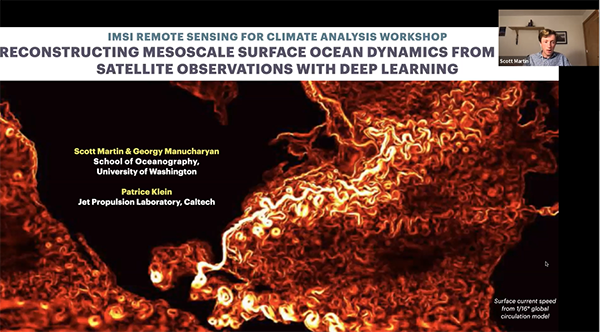Reconstructing surface ocean dynamics from sparse satellite observations with deep learning
Presenter
November 30, 2022
Event: 37468
Abstract
Two-dimensional sea surface height (SSH) reconstructions from satellite altimeter observations are an important dataset for studying upper ocean dynamics. Reconstructing the full SSH field is challenging since observations are currently only made along one-dimensional tracks widely spaced in time and space, leaving large gaps unobserved. To date, optimal interpolation has been used, yielding a SSH reconstruction accurate on large scales across much of the ocean. However, in regions with energetic mesoscale turbulence, this reconstruction shows significant errors, with some mesoscale eddies missed entirely and others distorted. These errors could impact our physical interpretations of ocean dynamics affecting, for example, such higher-order statistical metrics as the oceanic kinetic energy spectra and spectral energy fluxes.
A successful reconstruction method must account for the non-linear dynamics governing SSH evolution. We attempt to incorporate non-linear dynamics into the interpolation using deep learning.
Why deep learning? Deep learning models can learn non-linear mappings from input data to a desired output given sufficient training examples, so it is plausible that such a model could be trained to learn the dynamics of mesoscale ocean turbulence. We thus hypothesize that a neural network can be trained to recognize and reconstruct patterns of mesoscale turbulence even from relatively sparse observations.
Here, we design and train a neural network for reconstructing SSH from real-world satellite observations with active mesoscale turbulence. We augment the SSH data with observations of other physical quantities which, from the physics, we expect to influence SSH dynamics.
Our results are promising, with a lower RMS error than optimal interpolation when tested against independent observations, a higher effective spatial resolution, and qualitatively more physically realistic mesoscale features. Preliminary results from applying our method to a region of the ocean with energetic mesoscale turbulence suggest our new SSH map could lead to a significant re-estimation of the kinetic energy associated with surface ocean currents when compared to previous satellite altimetry studies, a result that would have implications for global climate if borne out on a global scale. We discuss the limitations and challenges of our methodology, its advantages relative to traditional interpolation and data assimilation approaches, and our ideas to improve upon and apply this work in the future.
